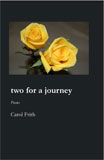Review by Nausheen Eusuf
David Robert Books
P. O. Box 541106
Cincinnati, OH 45254
ISBN 978-1934999837
2010, 96 pp., $18.00
www.davidrobertbooks.com
Carol Frith’s two for a journey revolves around two central characters, the “two” of the title: the “I” of the poems, and the “you” who is addressed throughout. The poems are a delicate rendering of the tensions and silences that are palpable in the air between the two. They probe with unflinching honesty and plangency the emotional terrain between two that are inseparably linked in this journey together. These are not the quarrels of young lovers, but the involutions of a deep and intense intimacy—the heart of mystery, a “sense / of something silent” that transcends them both.
Most of the poems involve the two characters in dialogue with each other, but when they speak—or even when they argue—their speech is beautifully oblique and allusive. Often they speak using the language of form, color, light, and texture. At other times, they speak through the landscape that surrounds them—through the grass, the sunlight, the flowers, the air, the rain, and the domestic spaces of the porch, the patio, the lawn. The landscape inhabits them as much as they inhabit the landscape. The “neurasthenic glare” of the light, the air that is “our own recycled breath,” the “blank sea of flowers” and the “sun-scorched grass” are imbued with their moods and become the language of their communion.
One poem defines love as “a question of movement and / color,” which also comments aptly on the collection itself. This is a story told in color, the dominant color being yellow—the yellow of the roses on the cover to the yellow that suffuses the collection, from yellow grass and air and light to yellow songs and sighs and heat. The color yellow is associated with the narrator, while the “you” is associated with blue: his “blue hands,” the “dark blue silence” between them, the tension between them “bluer / than the sea.” Occasionally, there are dramatic intrusions of other colors, such as the pink that characterizes the seductress of “Salt”:
The woman shifts. Her breasts crackle like flames
and turn pink as flamingos.
…and the orange that is the bitter citrus of reconciliation in “Corona: After-image” #6:
I taste you; citrus burns my palate, a case
of pungency. Your juice is bittersweet.
. . . I say orange, orange, a surfeit
of citric acid in the fragrant heat—
the scent of you entirely adequate.
I also enjoyed how the two characters experience the world synaesthetically; the senses merge or run together as do their lives: vowels are “thin arcs of light,” phonemes are “weightless in my palm,” a song is “like blue smoke,” and sunlight “crumbles in my palm.”
As the use of color and synaesthesia suggests, Frith’s poems have a painterly quality in their attention to not only color, but also light, shade, form, pattern, and texture. In addition to painting, the poet’s vision is also informed by photography: many of the poems concern surfaces, mirrors, exposures, reflections, and after-images. In “Wash of Water”:
You tell me I am counter-pressure, the second image
to your second image: I doubled into we.
Duplication, you repeat.
Mirrors in particular form a recurring motif—they are dangerous, they invite solipsism. And yet, the characters are drawn to mirrors and reflections as they try to understand themselves and each other, even mirroring one another in their movements and speech: “We are each other’s mime.”
I left for last what I admired most: Frith’s effortless and often inventive use of form. About half of the poems in the collection are sonnets, which includes two sonnet sequences (“Corona: After-image” and “Le Temps Perdu”) and a sonnet redoublé (“The Neighbor’s Rose”). There are also several villanelles and a sestina, with the rest being free verse, Frith being equally at ease in both free verse and form. I particularly admired the sonnet redoublé “The Neighbor’s Rose” which I think of as the center piece of the collection, and the two terza rima sonnets, “Mourners in Half Light” and “Birch,” where the use of tercets rather than quatrains creates a constant feeling of being off-balance and impelled towards to the next stanza by the rhyme. In “Sestina: After Muses,” if the form’s strict pattern of six interlaced end-words wasn’t constraint enough, Frith constrains herself further by making the six end-words share the same two rhymes. The effect of the constantly rhyming end-words is suffocating, hypnotic, almost deranging—which is exactly what the poem is about, so that sound and sense are perfectly in accord. Likewise, the repeating lines of the villanelle “Airless” reinforce and reenact the circularity of the argument in which the two characters are trapped: the narrator admits that “we circle” and “we’ve lost our plot” and yet they keep on going in circles, both in the argument and in the villanelle.
The poems of two for a journey find words for subtle and elusive registers of feeling even as they grapple with the difficulty of communication itself. Like the love they celebrate, the poems in this volume will linger with the reader, “ringing like an un-struck bell.”